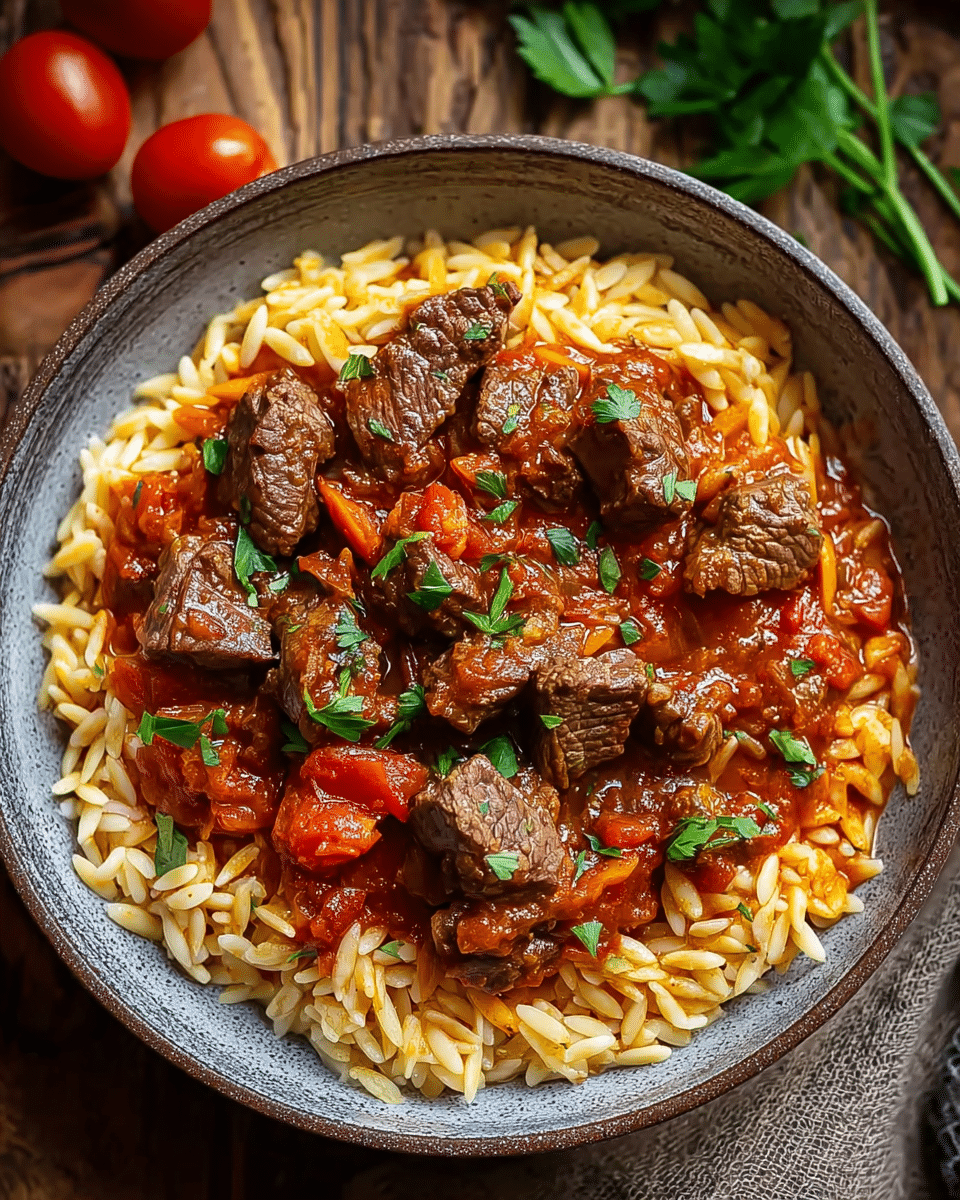The heart of Greek cuisine lies in its soul-warming, family-style dishes and Beef Giouvetsi is no exception. This timeless favorite combines tender chunks of slow-braised beef with orzo pasta simmered in a fragrant tomato-based sauce seasoned with cinnamon, bay leaves, and allspice. It’s a symphony of savory flavors and satisfying textures, baked to perfection and topped with a snowfall of salty Kefalotyri cheese.
Whether served for a festive gathering or a cozy family meal, Beef Giouvetsi brings the Mediterranean spirit to your table. Its simplicity is part of the charm, requiring just one pot and a little patience for a result that feels like a warm hug from Greece. Pair it with a fresh Greek salad and crusty bread for a full-on feast that’s both traditional and unforgettable.
Full Recipe:
Ingredients:
For the Beef:
-
2 lbs (900 g) beef chuck or stew meat, cut into cubes
-
2 tbsp olive oil
-
1 large onion, finely chopped
-
3 garlic cloves, minced
For the Sauce:
-
1 can (14 oz) crushed tomatoes
-
2 tbsp tomato paste
-
1 cup beef broth
-
1 cinnamon stick
-
2 bay leaves
-
1 tsp ground allspice
-
Salt and pepper to taste
-
1 tsp sugar (optional, to balance acidity)
For the Pasta:
-
1½ cups orzo pasta
-
2 cups hot water or beef broth (as needed)
Optional Toppings:
-
Grated Kefalotyri cheese (or Parmesan)
-
Fresh parsley for garnish
Directions:
-
Sear the Beef:
Heat olive oil in a Dutch oven over medium-high heat. Season beef with salt and pepper. Sear in batches until browned. Remove and set aside. -
Prepare the Sauce:
In the same pot, sauté onion for 3-4 minutes until soft. Add garlic and cook for 1 minute. Stir in tomato paste, cooking for 1-2 minutes. Add crushed tomatoes, beef broth, cinnamon stick, bay leaves, allspice, and sugar. Mix well. -
Simmer the Beef:
Return seared beef to the pot. Cover and simmer on low heat for 1.5 to 2 hours until tender. -
Add the Orzo:
Preheat oven to 375°F (190°C). Stir orzo into the sauce. Add water or broth if needed. Transfer to oven or continue on stovetop. Cook for 20-25 minutes, stirring occasionally until orzo is tender. -
Serve:
Remove cinnamon stick and bay leaves. Garnish with grated cheese and parsley. Serve hot.
Prep Time: 15 minutes | Cooking Time: 2 hours 30 minutes | Total Time: 2 hours 45 minutes
Kcal: 450 kcal | Servings: 6 servings
Beef Giouvetsi: A Taste of Greek Comfort and Culinary Tradition
In the rich tapestry of Mediterranean cuisine, few dishes speak to the heart and heritage of Greece like Beef Giouvetsi. This soul satisfying, one-pot wonder brings together tender beef, silky orzo pasta, and a richly spiced tomato-based sauce in a union that is both humble and unforgettable. Whether you grew up enjoying it at your YiaYia’s Sunday table or you’re discovering it for the first time, Beef Giouvetsi is more than just a meal it’s an experience, a story, and a celebration of comfort food the Greek way.
A Dish Rooted in History and Tradition
Giouvetsi (sometimes spelled youvetsi, yiouvetsi, or giouvesti) is a staple in Greek households, especially on Sundays or special occasions. Its roots trace back to the Ottoman era, and it shares culinary DNA with other baked dishes found throughout the Balkans and the eastern Mediterranean. The term “Giouvetsi” actually refers to the type of clay pot in which the dish was traditionally baked wide, round, and shallow, made for slow cooking and even heat distribution.
While the clay pot has become optional in modern kitchens, the essence of the dish remains intact. It represents the kind of food that invites people to gather, share stories, and indulge in a dish that feels as timeless as it is satisfying. Traditionally prepared with lamb or beef, Giouvetsi’s appeal lies in its balance of bold spices and soothing textures.
The Flavor Profile: Bold, Warm, and Comforting
At its core, Beef Giouvetsi offers a flavor journey that’s rich and layered. The beef is typically browned and then slowly simmered in a spiced tomato sauce, making it fork-tender and deeply flavorful. Aromatic elements such as cinnamon, bay leaves, garlic, and allspice lend a subtle warmth and complexity, creating a sauce that’s savory, slightly sweet, and utterly inviting.
What elevates this dish even further is the use of orzo pasta a small, rice-shaped pasta that acts like a sponge, absorbing the meaty, spiced tomato sauce while retaining a satisfying bite. As the orzo cooks in the same pot as the beef, the entire dish becomes a unified whole rather than separate parts, making each spoonful rich and cohesive.
A final topping of grated Kefalotyri cheese (or Parmesan for those outside Greece) adds a salty, sharp finish that cuts through the richness and adds a delightful contrast.
Why This Dish Resonates with So Many
Beef Giouvetsi is the epitome of what makes Greek home cooking so beloved: simplicity, heartiness, and deep-rooted cultural significance. It doesn’t rely on trendy ingredients or complicated techniques. Instead, it uses pantry staples and a slow cooking process to extract maximum flavor.
It’s the kind of meal that evokes emotions the smell of garlic and cinnamon slowly simmering together can transport anyone to a rustic village kitchen in the Greek countryside. This emotional resonance is one of the key reasons Giouvetsi continues to grace both holiday tables and weeknight dinners alike.
Regional Variations and Modern Adaptations
Though beef is one of the most common proteins used today, Giouvetsi is far from a one-size-fits-all dish. Depending on the region or family tradition, you might encounter:
-
Lamb Giouvetsi – Considered the most traditional version, especially in the Peloponnese region.
-
Chicken Giouvetsi – A lighter alternative that cooks more quickly and is popular for weekday meals.
-
Seafood Giouvetsi – Made with shrimp or calamari and white wine instead of beef broth, common in island regions.
-
Vegetarian Giouvetsi – A modern twist that substitutes meat for hearty vegetables like mushrooms, eggplant, or zucchini, with a dash of smoked paprika for depth.
Even the pasta component can be swapped out. While orzo (kritharaki in Greek) is standard, some cooks use trachana (a fermented grain pasta), rice, or even barley for a slightly different texture and nutritional profile.
Cooking Tips for the Perfect Giouvetsi
While the recipe itself is straightforward, a few thoughtful tips can elevate your Giouvetsi from good to unforgettable:
-
Choose the Right Cut of Beef
Well-marbled cuts like chuck roast or stewing beef are ideal. These cuts break down beautifully over time, delivering tender, melt-in-your-mouth results. -
Don’t Skip the Browning
Browning the beef at the beginning is crucial. It adds layers of flavor to the final dish, thanks to the Maillard reaction that occurs during the searing process. -
Control the Liquid
Orzo has a habit of soaking up more liquid than expected. Keep an eye on your pot during baking, and be ready to add a splash of hot water or broth if needed to prevent the dish from drying out. -
Let It Rest
As tempting as it is to dive right in, letting the dish rest for 5–10 minutes after cooking helps the flavors meld even further and gives the orzo time to settle. -
Cheese Matters
Kefalotyri is the cheese of choice for an authentic touch. If unavailable, Pecorino Romano or Parmesan are excellent substitutes. A sprinkle of cheese just before serving adds a salty punch that enhances every bite.
What to Serve With Beef Giouvetsi
Beef Giouvetsi is a complete meal on its own, but adding a few accompaniments can make the dining experience even more memorable. Some popular pairings include:
-
Crusty Greek bread – Perfect for soaking up the last bits of that delicious sauce.
-
Horiatiki salad (Greek salad) – The bright flavors of tomato, cucumber, feta, and olives provide a fresh contrast to the rich main dish.
-
Roasted vegetables – Simple roasted carrots, zucchini, or bell peppers add color and nutritional balance.
-
Red wine – Bold reds like Agiorgitiko or a Cabernet Sauvignon match beautifully with the earthy spices and tender beef.
A Dish That Ages Beautifully
One of the delightful secrets of Giouvetsi is how well it stores and improves over time. Much like stews or lasagna, the flavors deepen and mellow as they sit, making leftovers not only convenient but also incredibly delicious.
It’s also freezer-friendly. Stored in an airtight container, it can be frozen for up to three months. Reheating is as simple as adding a splash of broth and warming it over low heat.
Conclusion:
Beef Giouvetsi is more than just a dish it’s a window into Greek culinary heritage, a vessel for storytelling, and a testament to the power of simple ingredients cooked with care. It captures everything that Mediterranean cuisine is celebrated for: balance, depth, warmth, and heart.
Whether you’re exploring Greek food for the first time or preserving a family tradition, Beef Giouvetsi offers a wholesome, flavorful, and deeply satisfying experience. It invites you to slow down, savor the moment, and connect with something timeless and nourishing.
So the next time you’re craving a meal that comforts both body and soul, let this Greek classic grace your table. You may just find it becomes a cherished favorite for years to come.






